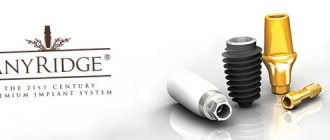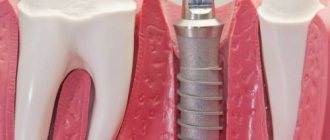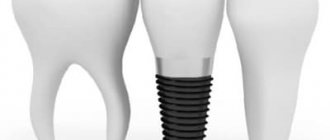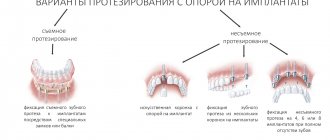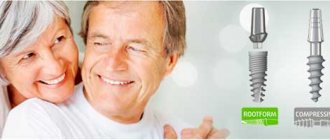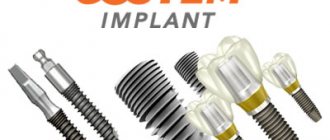Dr. Kizim
>
Articles
>
Biomed implants are the optimal choice for basal implantation
In orthopedic dentistry, dental prosthetics using the implantation method is becoming increasingly common. The main factors ensuring a successful operation are a high-quality implant and the skill of the implantologist.
At Dr. Kizim's clinic you use Biomed implants manufactured by the Swiss company Ihde Dental AG. They are distinguished by high quality and reliability.
Ihde Dental AG is a manufacturer of high quality implants
was founded in 1954 as a company selling medical instruments. Only for the last twelve years has he been developing implants, during which time several types of implantation systems have been developed.
The products are patented and certified according to international standards. With the support of the company, educational forums, trainings, and courses aimed at improving the qualifications of dentists are regularly held.
Ihde Dental is represented by a developed network of representative offices in more than 45 countries. In Russia, the products are sold by Oneway Biomed.
What is the survival rate of Biomed implants?
Ihde Dental claims a survival rate of 98.2% for its implants. However, there are no publicly available scientific publications confirming this figure. Clinical studies on Biomed implants are not presented either on the manufacturer’s website or in electronic scientific libraries where such materials are posted.
In 2003, a group of independent specialists from 5 countries conducted a large-scale study in which they assessed the quality of dental implants from 80 manufacturers. The authors reviewed scientific articles on implants presented in medical databases (Medline, Embase, Cochrane Library) and dental journals. The results of the review showed that only 10 manufacturers have conducted a sufficient number of clinical studies that confirmed the quality of their implants. Ihde Dental was not included in the top leaders. Experts assigned category C to the studies conducted by this company (“low level of evidence”).
Manufacturing technologies
The composition of the implants is pure titanium Grade 5. They are produced using technologies developed by the company based on its own research. Subject to:
- sandblasting;
- acid etching at high temperatures;
- electrochemical surface treatment (leveling, application of an osmo-active substance).
High-tech production methods provide less resistance when screwing in and high sterility.
What are the features of Biomed implants?
- High level of biocompatibility with the tissues of the human body : products are created on the basis of high-quality titanium alloy, which does not contain toxic substances, does not cause rejection reactions, and is durable and reliable.
- Wide range of models . The manufacturer has developed and produces more than 300 variants of implants. Such a wide range makes it possible to choose the best option for any clinical case.
- Application of advanced technologies . When installing Biomed implants, a 3D computer modeling program is used, which selects the most suitable areas of bone for the introduction of artificial roots, which eliminates the risk of tissue injury. And the use of individual surgical templates helps to fix the product in the right place and at a specific angle.
- Minimally invasive installation . The special design of the implants allows the use of a minimally invasive method of installation, which does not require large incisions on the gums with detachment of the mucous membrane and periosteum, suturing and a long healing period. When the implant is screwed into the bone, pressure is created on the surrounding tissues, which become compacted, which improves the reliability of fixation.
- Reliable osseointegration . Biomed implants are distinguished by a rough coating, into the microscopic pores of which growing bone tissue cells penetrate over time, which significantly accelerates the process of fusion of a foreign body with living tissue into a single conglomerate. A design feature of one-piece models is a smooth neck, which prevents the formation of plaque, which prevents the proliferation of bacteria and the development of inflammation in the area where the implant adheres to periodontal tissues.
Features of manufactured Oneway Biomed implants
- Restoration of jaw functions within 3 days, strong fixation of the rod in a short time after prosthetics.
- Immediate load on the prosthesis activates bone remodeling processes, and faster osseointegration occurs (unification, bonding of the titanium root with the bone).
- Average level of system stability immediately after installation.
- The operation does not require general anesthesia; local anesthesia is sufficient.
- Treatment is possible without bone augmentation.
System catalog
Classic two-piece GIH implant
There are two series:
- " Direct ". Indicated for use with small holes. Not suitable for installation in high pressure areas (molars) or diagonal loads.
- «6+2" Designed for installation in the molar area. Wider and much shorter than the first line.
Features of GIH (Hexacone) rods:
- screw type, GIH Direct has compression properties;
- 12-sided connection of the abutment (the part on which the crown is attached) to the base;
- compatibility with popular foreign implantation systems, because many types of implants are analogues of well-known manufacturers;
- a full range of production processing: sandblasting, application of an osmo-active substance, acid etching.
Implants for narrow bone GXI
They differ in the following characteristics:
- screw type;
- a wide variety of sizes: diameter of the intraosseous part - from 3 to 4.5 mm, length - 8-15 mm;
- two precise cylindrical guides for adjusting the position of the structure;
- 6-sided connection of the abutment with the base;
- made of pure titanium.
One-piece compression implants GCS (KOS)
There are three main modifications:
- Main . The abutment is straight and immovable.
- " A ". The abutment is inclined to the base and is motionless.
- " B ". The connection between the abutment and the base is flexible, which allows the dentist to independently tilt the implant at the desired angle.
Features of GCS (KOS):
- screw type with compression properties;
- monolithic design;
- 8-sided abutment head.
Cortical GBC implants for basal implantation
Two modifications are available:
- Standard.
- With reinforced abutment.
Features of GBC (BCS) implants:
- screw type;
- fastening occurs in the basal and cortical parts of the bone;
- the surface of the rod is polished and self-tapping;
- can be installed together with dental bridge structures;
- There is protection against rotation during manipulation.
Lateral disc-based implants (TOI, BOI)
The main element of fastening lateral structures is plates located on a common base. They are practically not used due to the high level of trauma during installation and low survival rate.
- One-piece BOI.
- Two-part TOI.
Differ:
- number of plate elements;
- size, shape of the plates;
- distance between the plates.
Features of Lateral implants:
- plate type, T-shape;
- The main method of fixation is mechanical.
They are used for bone atrophy due to the large attachment area.
Basal implants: reviews and characteristics
Ihde Dental basal implants are produced under the brands BCS® and KOS® - made of high-quality medical grade 5 titanium (Ti-6Al-4V) with the addition of aluminum and vanadium. This company’s line of implants also includes the BOI® basal implant, but its installation is very traumatic, and in fact this model is only an outdated form of basal implants.
- Implants BCS® (Fig.6) –
These implants have a smooth, electro-chemically treated No-Itis® surface. Such a surface has a high ability to repel bacteria, which prevents the migration of bacteria from the surface of the mucous membrane along the neck of the implant to the osseointegration zone. This is very important to reduce the risk of developing peri-implantitis.
- Implants KOS® (Fig. 7) –
This is a compression-type implant, the fixation of which is carried out in both the basal and cancellous layers of the bone. The surface of these implants is subjected to double sandblasting and high-temperature acid etching, followed by the application of a special Osmoactive® coating, which promotes accelerated osseointegration of the implants.
Examples of clinical applications –
1) Clinical case - fixed prosthetics of a completely edentulous upper jaw on BCS® implants...
2) Clinical case - fixed prosthetics of a completely edentulous upper jaw on BCS® and KOS® implants...
3) Clinical case - installation of 3 Ihde Dental implants and a metal-ceramic bridge prosthesis in the absence of 5-6-7-8 teeth in the lower jaw...
How effective are basal implants - reviews from patients (especially those who have previously used removable dentures) are in most cases positive. According to studies, the survival rate of implants of this type in patients is: 98% success in the lower jaw and about 95% in the upper jaw.
It should be noted that in the lower jaw the success rate is always higher, which is associated with a denser type of bone tissue (the lower jaw is characterized by denser bone types D1 and D2). In the upper jaw, the bone is always softer, which is not very good for implantation in principle (24stoma.ru). The upper jaw is characterized by softer bone types D3 and the softest - D4 (mainly found in the lateral areas of the upper jaw).
Cons : Patient reviews of basal implants are sometimes negative. This is primarily due to the contour of the gum around the implants if they are placed in the area of the front teeth and the patient has a high smile (i.e. with gum exposed).
- This type of implant is not very suitable for replacing single missing teeth. Indications for their use are more extensive defects in the dentition, for example: the absence of 2-3 or more teeth in a row, as well as completely toothless jaws.
- If you are missing only a small group of front teeth and have a high, gum-exposing smile, then it is best to go with traditional types of implants. This is due to the importance of obtaining good aesthetics of the gingival margin, which will be visible when smiling, and classic implant models cope with this task better.
Advantages
The main advantages of Oneway Biomed rods:
- quick installation (average time - 3 days);
- immediate load;
- the starting material is a biocompatible titanium alloy (provides natural engraftment and a low likelihood of developing allergies);
- applicable for the treatment of complex cases (lack of bone, inflammatory processes);
- the possibility of installation without the procedures required for traditional implantation (sinus lifting, bone augmentation), as a result, a reduction in the overall cost of treatment;
- a large number of available models;
- high-quality surface treatment of implants;
- long warranty - from 25 years to lifetime (specific figures depend on the clinic);
- low invasiveness - screw-type systems are installed without cutting the tissue;
- Possibility of use in case of contraindications to the installation of conventional rods (smoking, bone insufficiency);
- discomfort before and after surgery is minimized.
Advantages and disadvantages
Biomed products are focused primarily on implantation with immediate loading. Thus, implants of this brand offer a comprehensive solution to the problem associated with the loss of all teeth in a row, even against the background of a lack of bone tissue, periodontitis and periodontal disease. The main advantages of the products also include the following characteristics:
- rapid fusion with bone,
- possibility of providing immediate load,
- low risk of damage to living tissues,
- safety due to the use of computer modeling,
- possibility of installing the structure into deep layers of bone,
- no risk of developing allergies,
- a wide range of abutments,
- lifetime warranty.
The main drawback of the brand is that the company pays significantly less attention to the two-step technique. The manufacturer offers only one model for delayed loading. However, this is a relative minus, since this approach allows you to focus on exactly one, advanced direction in the field of dental implantation.
Quality and certification
Ihde Dental products are certified according to the international standard ISO 13485 and registered in state registers of medical devices. Meets the quality requirements of the EEC (European Economic Community).
After production, the products undergo quality control and are then delivered to clinics. According to Roszdravnadzor, they are classified as products with a potential risk of 2b (increased degree of risk). Registered implants from other companies are also class 2b or 3 (high risk).
Disadvantages of products
The disadvantages mainly relate to basal systems, which are often perceived by dentists with prejudice. Causes:
- High demands on the skills of doctors . Installation of basal implants requires good qualifications and strict adherence to the protocol.
- High risks . Patients are not insured against accidental errors or the consequences of negligence. In case of complications or incorrect installation, removal of the implant is possible only with part of the bone. Because deep, dense areas are involved, it can cause significant damage to the jaw structure.
- Some dentists claim that any Ihde Dental implants have poor osseointegration and are held in place mainly by friction. Immediate loading will gradually loosen the installed structure, leading to its rejection. In practice, basal implants often cause poor gum condition, even to the point of atrophy.
Main disadvantages:
- high installation complexity;
- frequent loss of oral aesthetics, discomfort;
- highly traumatic operation: causing significant damage to the gums, the need for surgical sutures;
- severe loss of bone over a large area due to rejection of the structure.
Basal implants: prices for 2022
We analyzed prices for Ihde Dental implants in clinics in Moscow and St. Petersburg. It should be noted that there are very few clinics that generally provide basal implantation services.
- Basal implants: price in Moscow for surgical installation of 1 BCS® or KOS® implant - from 32,000 rubles.
And the turnkey price of 1 implant together with a metal-ceramic crown will be about 46,000 rubles (a design of several implants is calculated in proportion to the number of implants and crowns on them). Prosthetics for a completely toothless jaw will cost you approximately 300,000 rubles. This price already includes the entire required number of BCS or KOS implants (from 8 to 10), as well as a permanent horseshoe-shaped bridge made of metal-plastic. In Moscow, these implants, but under the Oneway Biomed brand, are installed in the Smile-at-Once clinic.
- Basal implants: price in St. Petersburg for surgical installation of 1 BCS® or KOS® implant - from 22,000 rubles (plus an additional cost of a crown of about 12,000 rubles). In St. Petersburg, the installation of Ihde Dental implants is carried out by the “Clinic of Swiss Implantology” (swissimplant.ru).
Alternatives to implants Ihde Dental –
The best alternative to dental implants from Ihde Dental are basal and compression implants from ROOTT (Switzerland). The latter are structurally similar to Ihde Dental implants, but at the same time they have a higher quality of the surface of the root part (on which fusion with the bone depends), as well as an anodized neck. All this makes engraftment more predictable and reduces the risk of complications (especially in patients at risk - smokers, patients with diabetes, osteoporosis, hepatitis, etc.). We hope that our article on the topic: Basal implants reviews was useful to you!
Sources:
1. Dental education of the author of the article, 2. Personal experience as an implant surgeon, 3. National Library of Medicine (USA), 4. https://ihde.com/, 5. “Dental prosthetics on implants” (Surov O.N. . ).
Contraindications
Reasons to completely refuse or postpone the installation of Biomed implants:
- risk of complete lack of load or overload of implants (habit of chewing on one side, semi-paralysis);
- asymmetry of the chewing surfaces of the right and left sides;
- blood clotting disorder;
- deviations in the functioning of the nervous system;
- disruption of bone regeneration processes;
- pregnancy, breastfeeding;
- disturbances in the functioning of the immune system;
- chronic diseases:
- tuberculosis;
- insulin dependent diabetes.
Issues that pose less of a threat but require attention:
- chemotherapy;
- acute rheumatism;
- neuroses, mental disorders;
- inflammation of the gums;
- contraindications to anesthesia;
- poor oral hygiene.
- Complete restoration of the dentition in just 4 days!
more detailsRoott Pterygoid Implants Sinus lift is no longer needed!
more details
Once and for life! Express implantation in 4 days with a permanent ReSmile prosthesis
more details
All-on-4, All-on-6, ReSmile, Zygomatic implantation We use all modern methods of dentition restoration
more details
The presence of contraindications is not always a reason to exclude the installation of implants. The severity of the pathology plays an important role.
Indications and contraindications for implantation
Indications
Implantation of artificial teeth will be indicated in the following situations:
- presence of dental defects;
- increased tooth wear;
- complete absence or absence of several teeth in a row;
- absence of end teeth (there is no support for the prosthesis, it will be an implant);
- impossibility of installing a removable prosthesis, including due to rejection;
- lack of dental occlusion.
Contraindications
Contraindications to dental implantation can be both absolute and relative. The latter include, for example, easily curable diseases of the teeth and oral cavity (caries, gum disease) or general diseases of the body. After treatment, the implant installation procedure can be performed without interference. Absolute contraindications include:
- the patient's mental illness, which may interfere with implant placement;
- blood diseases;
- tuberculosis and complications of the disease;
- immune system disorders;
- bruxism (teeth grinding) and increased tone of the masticatory muscles;
- connective tissue diseases;
- endocrine pathologies;
- intolerance to anesthetics (without them installation is impossible);
- oncology;
- diabetes.
Installation process and implantation methods
Implantation is performed step by step:
- Calculation and modeling . The installation location is determined, the type of rod is selected, and its diameter and height are calculated. For the anterior sections, long, thin models are used, in the distal part - wider and shorter ones. If there are several implants, the doctor considers combining them with a prosthesis.
- Sanitation of the oral cavity, disinfection of the installation site . Necessary to prevent infection.
- Anesthesia (local or general).
- Preparation of the implantation bed . Facilitates insertion and ensures precise positioning of each titanium root. Several techniques are used depending on the type of rod being installed: Screw type. Using the drilling method, the surgeon makes a channel for the future implant. A hole in the second cortical plate is created using tapping instruments (eg, an elevator), allowing simultaneous assessment of bone quality based on the sound produced.
- Lamellar. A flap of fabric is folded back, sufficient for a good view of the work area. Muscles and other soft tissues are shifted to the side during the operation. Several channels are drilled, which are then combined into a single cavity.
- Screw type. Titanium roots are screwed into the prepared hole using a torque wrench with a fixed force. If the model is two-piece, an abutment is installed on the inserted implant.
- In case of unrelated implants: installation of a suitable crown on the abutment.
Caring for implanted structures
To maintain the good condition of the implantation system, follow simple rules for 10-20 days after surgery:
- avoid hard or sour foods;
- avoid stress and general overload of the body;
- maintain temperature balance: do not eat too hot or too cold food, avoid visiting the bathhouse or sauna.
Regardless of the time elapsed after surgery, maintain your immune system and maintain oral hygiene:
- brush your teeth twice a day;
- rinse your teeth after eating (with water or mouthwash);
- rinse the installed prosthesis with an irrigator.
It is not recommended to clean the area near the implants using standard dental floss. To avoid damage to oral tissue, use superfloss.
To exclude the development of complications and check the correctness of self-care for implanted dental roots, it is worth carrying out 3 scheduled check-ups with a dentist: after a month, after 3 months, after 7 months after implantation.
If there are signs of mobility of the structure, you must urgently contact the clinic to identify the causes. The mobility of the root part of the implant will indicate its rejection and the need for removal.
How long does it take to install Biomed implants?
| Service | price, rub. |
| Installation of one implant with immediate loading | from 35000 |
| Full jaw prosthetics using the “All-on-4” method | from 180000 |
| Complete prosthetics using the “All-on-6” method | from 230000 |
| Complete prosthetics supported by 8-12 implants | from 265000 |
If you compare the cost with other popular implants:
| Implant name | Turnkey installation price, rub. | |
| with metal-ceramic crown | with zirconium crown | |
| Made in Switzerland | ||
| ROOTT | from 54000 | from 60000 |
| Ihde Dental (Biomed) | from 60000 | from 80000 |
| Nobel Biocare (Nobel) | from 80000 | from 100000 |
| Straumann | from 80000 | from 100000 |
| Made in USA | ||
| 3i Biomet | from 50000 | from 67000 |
| Biohorizons | from 58000 | from 78000 |
| Bicon | from 65000 | from 80000 |
| Zimmer | from 85000 | from 100000 |
| Made in Israel | ||
| MIS (MIS) | from 45000 | from 55000 |
| AlphaBio (Alpha Bio) | from 40000 | from 55000 |
| Made in Russia | ||
| Niko (LIKO) | from 30000 | from 45000 |
How much does implantation cost with Biomed implants?
The prices of Oneway Biomed implants are in the middle price segment.
If 1-2 teeth are missing in a row, or if several teeth are missing in different segments of the jaw with two-stage implantation, the cost of installing one implant is 50,000 rubles .
With one-stage implantation if 3 or more teeth are missing, prosthetics for 3–5 dental units in one segment of the jaw will cost from 160,000 rubles .
If there is a complete absence of teeth in one jaw, installation of implants followed by prosthetics will cost 270,000 rubles; on two jaws - from 540,000 rubles .
